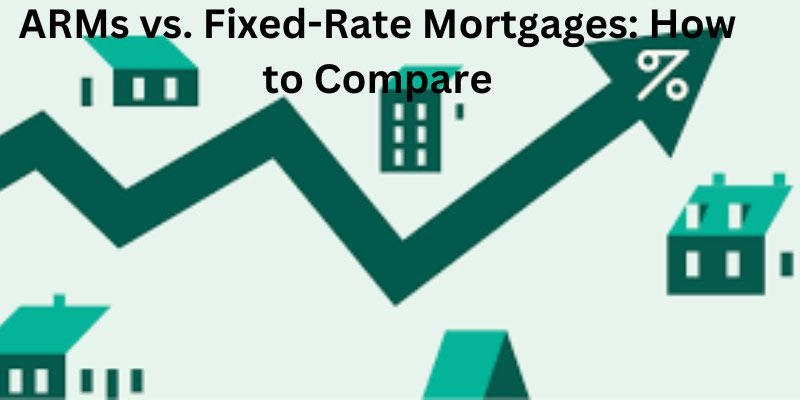
Are you considering buying a home soon and trying to decide between an adjustable-rate mortgage (ARM) or a fixed-rate mortgage? Understanding these two loan types' differences, benefits, and drawbacks is important to make the most informed decision.
In this blog post, we'll dive into all things ARMs vs. fixed-rate mortgages – from understanding how interest rates are calculated for each one to learning about closing costs and associated fees.
By the end, you can compare both types to make an educated choice when it comes time for financing your dream home.
Understand Fixed-Rate vs. Adjustable-Rate Mortgages
Before deciding, it is important to understand the differences between fixed-rate and adjustable-rate mortgages (ARMs). Fixed-rate mortgages offer predictable monthly payments for the duration of the loan, while ARMs may have lower initial interest rates but can change over time as the rate is adjusted according to market conditions.
Fixed-rate mortgages provide the security of knowing your monthly payments for the entire loan term. This makes it easier to plan a budget since you know exactly how much money will go toward your mortgage each month.
On the other hand, ARMs may have lower initial interest rates than fixed-rate loans, but the rate can change over time, making it more difficult to plan for budgeting and other financial needs.
How to Compare Loan Terms for Each Type of Mortgage

When comparing ARMs and fixed-rate mortgages, you should consider the loan terms for each type of mortgage. For example, with an ARM, you typically have a lower interest rate at the beginning of your loan term—which means your initial payments will be lower than what you would get with a fixed-rate mortgage.
However, this also means that your interest rate can (and likely will) increase over time. With a fixed-rate mortgage, you’ll have the same interest rate through the entire loan term, so you don’t need to worry about increasing costs later.
The loan period for each type of mortgage is another factor to consider. With an ARM, you typically have a shorter loan period than with a fixed-rate mortgage; your interest rate will be reset more often, and costs can change rapidly.
A fixed-rate mortgage usually has a longer loan period, so you’ll have the same rates for the entire duration of your loan.
Finally, review the fees associated with each type of mortgage to get an idea of the total cost. Some ARMs may have lower closing costs and fees than fixed-rate mortgages, while others may have higher costs. It’s important to compare all of these factors before deciding which type of mortgage is right for you.
Benefits and Drawbacks of ARMs and Fixed-Rate Mortgages
Both ARMs and fixed-rate mortgages have advantages and disadvantages. An adjustable-rate mortgage (ARM) may be an attractive option for those who plan to own their home for only a few years or those looking to purchase more homes than they can afford with a fixed-rate loan.
The initial interest rate on an ARM is usually lower than on a fixed-rate mortgage, and the payments during that period may be substantially lower.
However, since the rate on an ARM can change after a few years, if interest rates rise significantly, you may have to pay considerably more in interest each month than you would with a fixed-rate loan.
On the other hand, homeowners who plan to stay home for a long time may be better off with a fixed-rate mortgage. With this type of loan, the interest rate and monthly payments stay the same over the life of the loan, so you don’t have to worry about rising rates increasing your payment.
The downside is that it can be more expensive than an ARM in terms of the initial interest rate, and if you plan to move within a few years, it may not be worth taking out the loan.
Analyzing Interest Rates Over Time

One of the key differences between adjustable-rate mortgages (ARMs) and fixed-rate mortgages is how the interest rate fluctuates over time. With a fixed-rate mortgage, your interest rate stays constant throughout the life of the loan.
This means that your monthly payments will remain stable for years to come. On the other hand, an ARM may start with a lower initial interest rate, but it can fluctuate based on current market conditions. This means that your payment amount could change significantly over the life of the loan.
When comparing ARMs and fixed-rate mortgages, it’s important to analyze how both types of loans are likely to perform in terms of interest rates over time. This analysis can help you determine which type of loan is right for your financial situation.
For example, current market conditions suggest that interest rates will remain low shortly. In that case, a fixed-rate mortgage may be the better option since it will provide stability and security against potential increases in interest rates down the road.
On the other hand, if current market conditions suggest that interest rates will likely increase over time, an ARM may be more attractive since it allows you to take advantage of a lower initial rate while protecting against future interest rate increases.
However, it’s important to note that ARMs have inherent risks since you can’t predict how much your interest rate will increase over time.
FAQs
How do you choose between a fixed rate and ARM?
Choosing between a fixed-rate and adjustable-rate mortgage (ARM) depends on your financial goals. ARMs are attractive to those looking for lower initial payments, shorter loan terms, or more flexibility.
Fixed-rate mortgages offer the consistency of knowing that your interest rate won't change over time, and you can be sure of your monthly payment.
Is having an ARM or a fixed interest rate better?
It depends on your financial goals. An adjustable-rate mortgage (ARM) can benefit those planning to move or refinance within a few years, offering lower initial payments and shorter loan terms.
However, fixed-rate mortgages offer the security of knowing that your interest rate won't change over time so that you can be sure of your monthly payment.
How do you compare variable and fixed-rate mortgages?
When comparing variable and fixed-rate mortgages, consider the loan term, interest rate, monthly payments, closing costs, fees, and other terms associated with the loan. Compare each item across different lenders to compare rates and understand which option is best for your financial goals.
Conclusion
In conclusion, learning about fixed-rate and adjustable-rate mortgages is a great way to be informed and educated when making decisions about your finances. Understanding the benefits and drawbacks of both types of mortgages can give you an insight into what works best for your needs.



